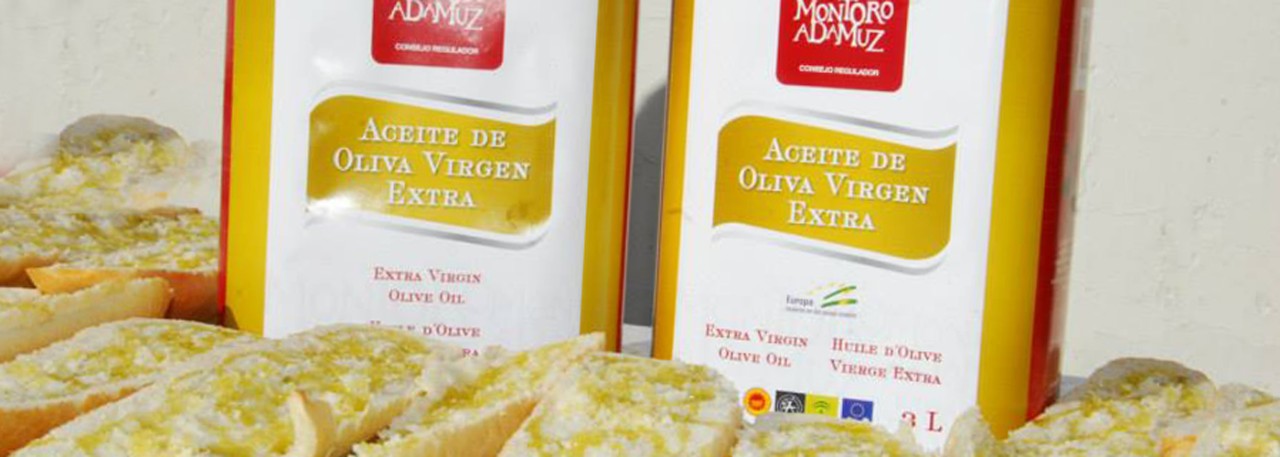.png.transform/rendition-xs/image_image%20(1).png)
Montoro-Adamuz PDO
Extra virgin olive oil obtained from the fruit of the following varieties of olive tree: Picual (Nevadillo Blanco) and Nevadillo Negro, although Lechín, Picudo and Carrasqueño varieties are also used in negligible quantities.
Tasting notes
These oils have great aromatic complexity, with intense olive fruitiness, a high green leaf content and hints of other ripe fruits. The oils are quite dense in the mouth, with great body, because of their high oleic acid content, and a characteristic average intensity spiciness and bitterness, with the fruitiness and green leaf flavors coming through very strongly.
Other notes
The oils have an acidity of less than 0.5º, humidity of under 0.1% and a maximum peroxide value of 20. They have a high oleic acid content, a high monounsaturates / polyunsaturates ratio and a high polyphenols content, giving it great stability and a characteristic bitterness.
Production / Processing method
The olive groves are normally planted in a 10x10 m / 32.8x32.8 ft pattern, although this may vary slightly; more recent plantations are done in smaller patterns, varying between 7x5 m / 22.9x16.4 ft and 9x9 / 16.4x16.4 ft. Densities range from 80 to 300 olive trees per hectare, with a predominance of groves of between 100 and 160 trees/ha.
The soil is not overly worked and normally consists of one or two passes with a harrow or wheel. On sharply sloping land, the soil is not worked and undergrowth around the trees is maintained. Vegetation is encouraged to grow underneath the trees as a method of preventing soil erosion.
As far a fertilizer use is concerned, the nutrients replacement method is used, as the soil is shallow and not particularly fertile. The fertilizer used is neutral pH or acid, depending on the requirements of the crop and the characteristics of the soil. Fertilizers are supplemented with organic material and calcium to improve soil structure and provide the nutrients that the trees need to thrive.
Pruning is done twice or three times a year: shaping from the time when the tree is planted until the skeleton (trunk and main branches) is fully developed; production pruning; light thinning and getting rid of suckers, in order to increase the quantity and quality of the harvest, and renewal pruning when the olive begins to age. This involves gradually replacing the main branches of the olive tree to completely regenerate the top.
Authorized pesticides and herbicides are used to control the pests and diseases that attack olive trees. They are only applied when the cost of the application is lower than the losses that would be caused by the pests if no action was taken.
The ideal time for harvesting is decided each year depending on the outcome of the analytical parameter study, but generally speaking, early harvesting is preferred.
The olives are collected both manually (beating with poles and hand picking) and mechanically, but care is taken to avoid fruit falling onto the ground by spreading canvas sheets or using other methods. The olives that have fallen on the ground are always separated, and only healthy, undamaged fruit obtained directly from the tree is used for producing the oils protected by the PDO.
After harvesting, the fruit is transported in bulk in rigid containers within 24 hours.
On arrival at the oil mill, the yards have systems to ensure that olives obtained from the ground and straight from the tree are unloaded separately, preventing qualities from getting mixed up before processing. The olives are weighed and calibrated in specially designated areas under the supervision of an operator, who is responsible for ensuring that the qualities are correctly classified and separated. The fruit also passes thorough specially adapted cleaning systems.
The olives are then pressed at the registered mills within 24 hours of their arrival.
The olives are first washed to remove soil and mud stuck to the skin, using drinking water but no detergents or any other kind of substance that could affect the properties of the product. Once cleaned and/or washed, a sample is taken from each batch for physical and chemical analysis, which will be recorded. The batch is then weighed.
The olives are then taken to be milled, a stage during which a hammer crusher grinds them into a paste or homogenous mass, formed by the pulp and the stone together, in order to extract the oil they contain. After milling, the paste is beaten, enabling the oily stage to be reached so that the oil can be obtained using mechanical procedures. During this stage, the temperature at which the paste is beaten is controlled, and under no circumstances can it be allowed to exceed 32º C / 89.6 º F. The only emulsifier permitted is properly approved food grade talc powder, which is used if the olives have a high water content (in excess of 58%). If it is used, the beater has a talc powder dispenser and the maximum permitted dose is 2.5%.
The authorized system for separating phases is continuous centrifugation (continuous systems of 2 and 3 phases):
a) Separation of liquid and solid phases by centrifugation of the paste (continuous systems of 2 and 3 phases): the temperature of the water supplied to the decanters should not exceed 32ºC.
b) Separation of liquid phases by centrifugation (continuous systems of 2 and 3 phases): in this phase the oil coming out of the decanter is cleaned by adding water to remove moisture and solid impurities. The water supply used must be drinking water and the temperature should not exceed 35º C / 95 º F, maintaining the positive temperature gradient from the beater to the vertical centrifuge.
The next phase is decanting, a compulsory process for continuous extraction systems, where remains of pulp particles are separated from the oil. The correct decanting capacity should not be less than 6 hours in centrifugation and 36 hours in gravity decanting. The temperature of the decanting room should be between 20 and 26º C / 68 and 78.8 º F. Decanting the oil from the vertical centrifuge to the tanks is done either by pumping or by gravity. The decanting room must be completely independent from other areas of the oil mill.
After the oil has been obtained, the various oils produced are classified, based on their physical, chemical and sensory characteristics.
The protected oil is stored in properly labeled tanks and kept apart from other virgin olive oils. The oil is stored in stainless steel tanks or tanks with an inert food standard internal covering through which light cannot pass. These tanks must be provided with a closure that guarantees they will remain sealed.
They must also be completely closed and cleanable, allowing regular drainage and sampling to take place. The storage areas must be air conditioned and maintained at an appropriate temperature to ensure the oil is correctly preserved. Proper stainless steel liquid food container trucks must be used to transport the oil to the packaging plant, and they must be in possession of the certificate of cleanliness supplied by the haulage company.
The oil is packaged only in PDO registered packing facilities.
Geography / Relief and climate
The ideal time for harvesting is decided each year depending on the outcome of the analytical parameter study, but generally speaking, early harvesting is preferred.
Regulatory Council
Consejo Regulador de la DOP Montoro-Adamuz
C/ Alto Guadalquivir, 6
14430 Adamuz (Córdoba)
Tel: (+34) 957 166 013
info@montoro-adamuz.com
www.montoro-adamuz.com
Sources:
- Spanish Ministry of Agriculture
The ideal time for harvesting is decided each year depending on the outcome of the analytical parameter study, but generally speaking, early harvesting is preferred.


- Montoro Adamuz 1
- Montoro Adamuz 2
